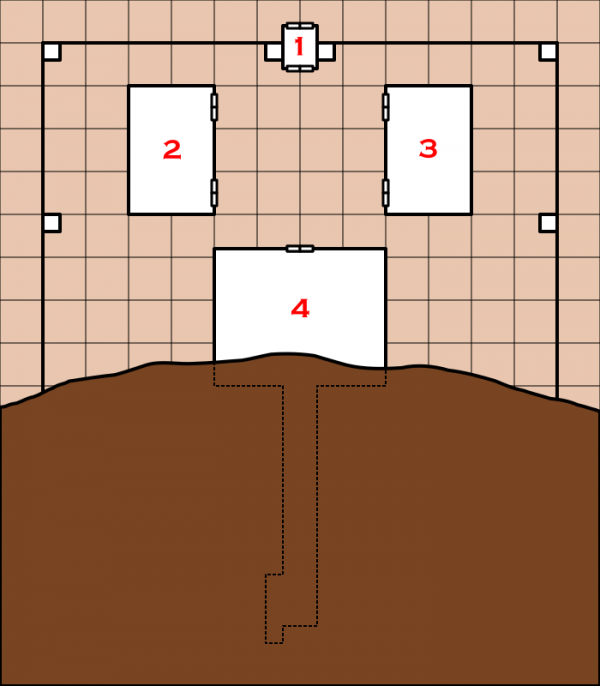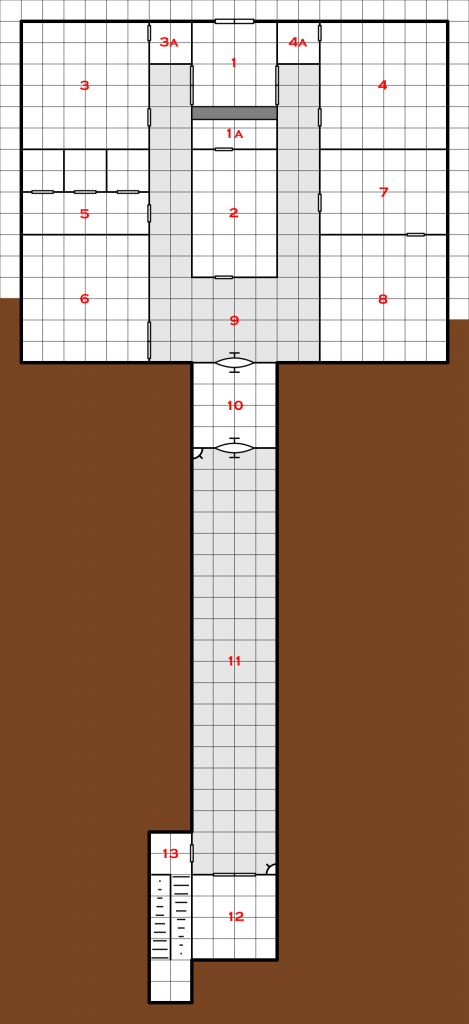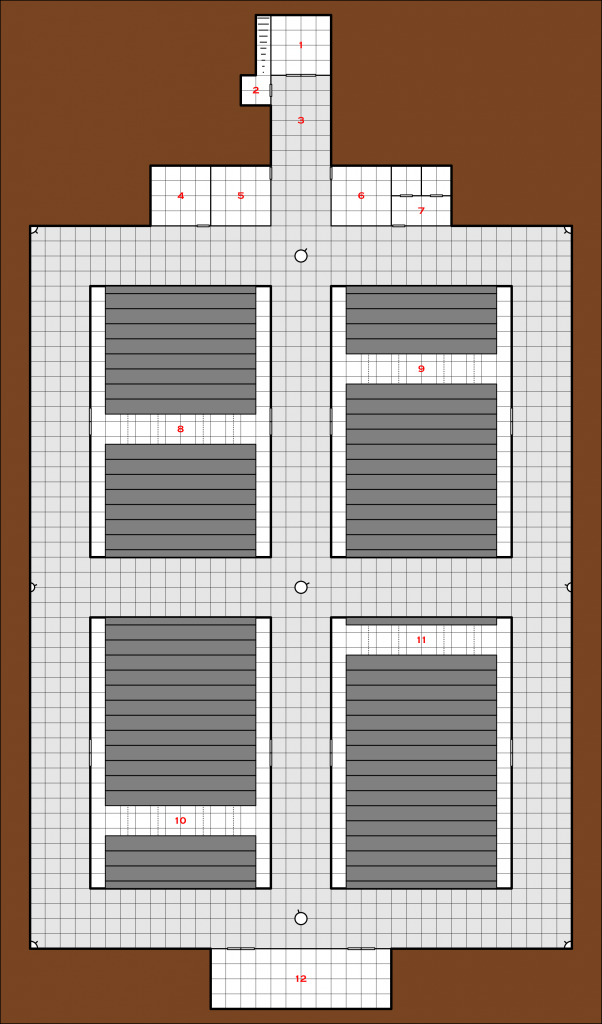Merry Christmas, Happy Holidays, and Season’s Greetings. Here’s a post just in time for you to enjoy as you’re snuggled up to your fireplace on Christmas Eve.
In my first post about the records vault, I provided the maps and room descriptions, then I posted a few robots that also make an appearance although I didn’t specifically call them out as part of this project. In this post I provide the rest of the information about the records vault as well as a PDF with the complete write-up of the location.
In this post we’ll add in the details on the staff, the main computer, how to get “official” access to the vault, and how the vault and its staff respond to external or internal threats or problems. Let’s get started.
Gaining Access
In order to gain access to the data in the records vault, a person or organization needs to file a request with the PGC headquarters on Laco, located in Point Glass. The request includes the dates they desire to visit, the number of people to visit the vault, and the research topic. If the request is granted, the requestor is given an appointment date and an access code that will allow them through the outer gatehouse.
Once inside the main building the visitors’ ID are checked by the security guard at the front desk and then on of the archivists are called to escort them to the research room. Each visitor is given a unique passcode to access the computer terminals. This code is keyed to the level of access (typically just public although private/full access is available to PGC employees) which determines which data in the vault they have access to. It is also used to record the queries in the system so that PGC can track who is searching for what information and the type of queries being performed.
The main computer only contains an index of all the data stored at the vault and provides an interface so that the user can search for the type of data they are looking for. Once found, the actual data is then requested. Once the request is submitted, one of the two data retrieval robots (area 6) is activated, goes down to the vault, retrieves the requested data cubes and brings them up, and places them in the data portals in the computer room (area 8). It takes 7-10 minutes from the time the request is submitted until the data is available. Once the data cubes are in place, the computer informs the user that the data are available and the researcher can begin searching and looking through the actual data for the information they need.
If a researcher has any questions, problems, or difficulties, they can page one of the archivists who will come over from their office (area 4) and attempt to help the researcher.
Repeated queries about classified/locked information may trigger the user to be locked out of the system. This typically only applies to queries on PGC corporate details and operations or some restricted Tetrarch data when using a public access account.
Robots
There are three types of robots at the records vault facility that help keep the facility running:
- sixteen S-037 Security Robots
- four M-022 Maintenance Robots
- two G-092 Data Retrieval Robots
The details on each of these types of robots were given in the previous post. I’m not going to repeat them here.
Staff
The records vault nominally has a “daytime” staff of 10 PGC employees: the vault administrator and administrative assistant, two security officers, a roboticist/technician, and five researchers/archivists. In addition to the base staff, there are often outside researchers working with the data stored in the vault. The facility can accommodate up to six visitors.
During the “night” shift, there are just two security guards at the facility. You can just reuse the stats for Nameer and Erich or create similar characters if the PCs decide to try a night raid on the facility.
Note: Skill are taken from the “A Skilled Frontier” skill system published in Star Frontiersman issue 9 as that system provides some actual skills for the archivists to have.
Zat’zra K’tar
Vault Administrator/Lead Archivist
Vrusk, Male
STR/STA: 50/50 DEX/RS: 55/55 INT/LOG: 40/40 PER/LDR: 55/55
Skills: History 4, Environmental 3, Politics 2, Computer 1
Equipment: chronocom, notebook, pen
Zat’zra is probably not the best of administrators or researchers which is probably why he’s assigned to this relatively out of the way records facility. But that suits him just fine. His administrative duties are light and he can spend his days working on his research. He rarely leaves his office (area 3).
Weldon Tindal
Administrative Assistant
Human, Male
STR/STA: 30/30 DEX/RS: 50/45 INT/LOG: 55/55 PER/LDR: 45/45
Skills: Law 2, Pop Culture 2, Persuasion 1, Projectile 1, Air vehicles 2, Literature 1
Equipment: chronocom, needler pistol, 2 needler clips
Weldon is bored out of his skull with his assignment here. He has very little work to do as the facility is small and Zat’zra rarely has any assignments for him. He can often be found in the break room chatting with whoever is in there.
Nameer Olnar
Head Security Officer
Yazirian, male
STR/STA: 45/45 DEX/RS: 65/65 INT/LOG: 75/75 PER/LDR: 50/50
Skills: Beam 5, Melee 4, Unarmed combat 1, Thrown 1
Equipment: chronocom, laser pistol, sonic stunner, sonic sword, 4 tangler grenades, albedo screen, military skeinsuit, power beltpack, 4 powerclips
Nameer is a career security officer and takes his assignment very seriously. He considers any boring day a good one since there were no threats to the facility under his care. While he takes his responsibility seriously, he also tries to keep the security requirements as much out of the way of the staff working at the vault as possible.
Erich Melchor
Security Officer
Human, male
STR/STA: 70/70 DEX/RS: 55/55 INT/LOG: 30/30 PER/LDR: 55/50
Skills: Beam 4, Unarmed Combat 2, Medic 1, Projectile 1, Technician 1
Equipment: chronocom, laser pistol, electrostunner, albedo screen, military skiensuit, power belt pack, 4 power clips
Erich couldn’t be happier with his current assignment to man the front desk at the records vault. Nothing ever happens and his busiest times are first thing after arriving and right before leaving for the day when he has to check all the visiting researchers in and out of the facility. The rest of the day he typically spends reading or watching holovids at the front desk.
Pluami Krennta
Roboticist/Technician
Yazirian, female
STR/STA: 40/40 DEX/RS: 45/45 INT/LOG: 60/60 PER/LDR: 35/35
Skills: Robotics 4, Computer 3, Technician 2, Enviromental 1
Equipment: chronocom, techkit, robotcom kit, pocket tool, toxy-rad guage
While she doesn’t consider the records vault to be a plum assignment, Pluami can’t complain about the level of work or availability of interesting projects. There are just enough robots at the facility that she has some maintenance that needs to be done each day alongside keeping the complex’s power system running in top shape. When she does have some free time, she likes to peruse the vault’s vast data sets looking for interesting robotics and tech data. She has starting looking through all the Tetrarch data for anything that might be robotics related and can often be found talking with Gh’dzz looking for new bits of data.
Kodub
Archivist
Dralasite, female
STR/STA: 35/35 DEX/RS: 35/35 INT/LOG: 55/55 PER/LDR: 35/35
Skills: Economics 4, Philosophy/Theology 3, Law 1, Computers 2
Equipment: chronocom
Kodub asked to be assigned to the records vault as she felt it would give her the best access to all the data she was interested in researching. Not particularly interested in the Tetrarchs themselves, she studies how the presence of the ruins has shaped the economic structures on Laco. She works out of the office on the main level (area 4).
Abigail Zemke
Archivist
Human, female
STR/STA: 50/50 DEX/RS: 55/55 INT/LOG: 55/50 PER/LDR: 45/45
Skills: Space Science 4, Law 2, Pop Culture 1, History 1, Melee 1
Equipment: chronocom, pocket tool, sonic knife w/powerclip
Abigail is a Laco native and grew up around the Tetrarch ruins at Point Glass. She was always fascinated by the space motifs found in the ruins and works at the records vault studying the astronomical and physical data found in the ruins in an attempt to nail down the time period that the planet was occupied by the Tetrarchs. She will be assigned as the PCs liaison when they arrive at the facility and has on office on the main level (area 4).
Gliprell Anthor
Archivist
Yaziran, female
STR/STA: 35/35 DEX/RS: 45/45 INT/LOG: 55/55 PER/LDR: 40/40
Skills: Environmental 4, Psycho-social 3, History 2, Literature 2
Equipment: chronocom
Gliprell is at the records facility studying Laco’s flora and fauna and how it has interacted and reacted to the presence of the Frontier races on the planet as well as the populace’s reactions to and interactions with the native life. Her office is down in the records vault (area 5) as she is constantly accessing new data cubes and is not quite patient enough for the retrieval delay working on the main level.
Gh’dzz Kl’tak
Archivist
Vrusk, male
STR/STA: 50/50 DEX/RS: 45/45 INT/LOG: 65/65 PER/LDR: 50/50
Skills: Literature 4, Robotics 2, Law 2, Xeno language (Tetrarchs) 1
Equipment: chronocom
Gh’dzz works out of the main level office (area 4) and is slowly researching the Tetrarch language. His specific interest is literature and poetry but without understanding the language, it is kind of hard to tell what the writings are about. Despite his main focus on literature, he also has an interest in robotics, specifically in task automation and keeps his eyes open for instances of that in the Tetrarch artifact data.
Yk’rtz T’tk
Archivist
Vrusk, female
STR/STA: 40/40 DEX/RS: 45/45 INT/LOG: 65/65 PER/LDR:70/70
Skills: Structural Art 4, Visual Art 3, Environmental 2, History 1
Equipment: chronocom
Yk’rtz plays right into the stereotype of a vrusk art fanatic, animatedly interested in all forms of physical and visual art. She works out of an office on the records vault level (area 4) where she is constantly reviewing the various artifact found across the planet. She also studies the impact of these artifacts on the art produced by the residents of Laco looking for Tetrarch influences in modern culture.
Main Computer
The vault’s computer is housed on the main level of the complex (area 8) and can only be accessed by the research room (area 7). The computer is level 4 (115 FP) and has the following programs:
- Analysis – 4
- Communication – 1
- Computer Security – 3
- Information Storage – 5
- Installation Security – 4
- Language – 4
- Life Support – 1
- Maintenance – 1
- Robot Management – 4
The installation security program controls the gate house, the door locks, all the security cameras, and the sonic stunner turrets throughout the compound. It does not control the security robots. It can issue orders but cannot disable them.
Similarly, the robot management program controls the maintenance and data retrieval robots but cannot control or disable the security robots, they are designed to operate independently of the main computer.
The computer itself does not contain the archived data. Rather the information storage program contains a giant, detailed index of the data archived at the site. The data are stored on data cubes that can be plugged into ports and then accessed via the various computer terminals throughout the building. One of the main roles of the archivists at the site is to keep this index updated as new data arrives each week.
All terminals in the building are connected to the main computer and grant access based on the passcodes supplied when logging into the program. Visitors only have access to the analysis, information storage, and language programs while the base staff have access to the programs needed to perform their functions.
The defeating security subskill can be used at any terminal, but the bypassing security subskill can only be employed on the main computer itself in area 8. Any failed attempt to use either of these skills immediately locks the terminal and notifies the security officers.
Threat Response
The exact response to any sort of threat will depend on the location and nature of the threat itself, some common possibilities are provided in this section. Any intruders captured will be detained, questioned, and transported to the PGC headquarters at Point Glass for further processing.
For the purpose of threat response, authorized personnel are the regular vault staff, whose visual, biometric, and id card information are stored in the main computer and robots, and visitors holding/wearing a special passcard only available from the PGC headquarters in Point Glass and used by visiting PGC personnel. Authorized visitors are those issued a visitor badge at the security desk (main level – area 1a) upon arrival. Anyone else is considered unauthorized.
Exterior threats
A common, low-level threat is a vehicle attempting to gain entrance through the gatehouse without a proper code. In this case, the main PGC compound in Point Glass is contacted to verify that there is not some mistake. If the visitor’s bonifides can be established, they are allowed to enter. Otherwise, they are simply turned away and asked to exit the gatehouse and leave the area.
If an air-vehicle (aircar, jetcopter, etc.) attempts to land in the compound, they are warned away unless proper clearance codes are provided before approaching within 1000 meters of the compound. At the 1000-meter range they are warned that deadly force will be used if they do not alter course. If the vehicle does not veer off, the robots in the guard towers will all open fire at 500 meters with the heavy lasers set to 20 SEU (maximum) damage in an attempt to down the intruding vehicle.
A similar response will occur for any land vehicles that attempt to approach the compound by any means other than the main access road.
If any group designated as hostile by the security officers or the vault’s installation security program are visible inside the compound or are attempting to escape, the robots will use their weapons to attack the intruders using their weapons in an attempt to get them to surrender. Beings will be attacked using a 5 SEU damage setting while vehicles will be attacked using a 20 SEU setting. Fleeing parties will be attacked both inside and outside the compound until out of range.
Main level threats
If an authorized visitor is found wandering the halls, one of the security officers or archivists will come find them and offer them assistance and remind them they are only allowed access to the restrooms, the break room, and the research room. A second offence will result is a stiffer warning, and a third offence will result in them being escorted from the complex.
If the security cameras detect unauthorized personnel in any of the offices, the robotics lab, or the computer room, the security officers will respond immediately and attempt to subdue the intruders. If necessary, they can call on the security robot from the hallway to the elevator (main level – area 11) and from the hallway (area 3) or robot storage area in the deep vault (area 12). Note that it will take at least 5 minutes for robots to come up from the deep vault due to the elevator travel times unless a data retrieval robot is currently down in the vault, in which case it will only take 3 minutes.
If any unauthorized personnel penetrate the security lock (main level – area 10), both the security robot and the stunner turrets will immediately engage the intruder with their stunners attempting to subdue them. If stunning is not effective, the robot will switch to its laser weapon set at 5 SEU to encourage surrender and will fight to kill if the target does not surrender.
Deep vault threats
Any access to any portion of the deep vault by unauthorized personnel will be meet by an immediate response from the robots and stunner turrets. Like the security hallway on the main level, stunning attacks will be employed initially but if they fail, the robots will switch to deadly force. If the three robots already in the halls are deemed insufficient for the task, the six extra robots in area 12 will be activated and sent to assist.
Final Thoughts
This took a lot longer than I thought it would. And ended up being a bit bigger than I expected as well. It started as two pages of maps in my notebook and five paragraphs (including the combat robot stat block) of description. In the end the PDF file (attached below) is 16 pages long.
I ran my group through the location using the five paragraphs of notes. If any of them are reading this, they have probably realized by now that I completely forgot about the security robots inside the complex. It would have made their life a bit harder. The staff details are really the only bit I added after the fact. I knew they were all their but didn’t have details on any of them when I ran the game. Everything else was in my head if not written down when they went through the vault.
I hope you enjoy the location and the details provided and can use it in your game one way or another. As always, feel free to leave comments, questions, or suggestions below. Here’s the PDF with the full write-up.


